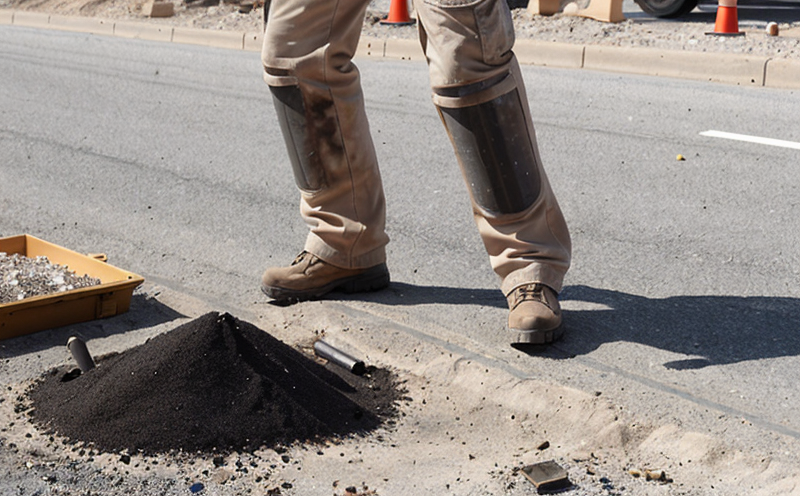EN 13631 Part 4 Determination of Cap Sensitivity of Explosives
The determination of cap sensitivity is crucial in ensuring the safe handling and transportation of explosives, especially within mining operations. This test, specified by EN 13631 Part 4, evaluates how sensitive an explosive cap is to impact forces during transportation or storage.
The cap sensitivity test aims to mimic real-world conditions where the integrity of the explosive cap might be compromised. This could occur in scenarios such as rough handling, dropping, or mechanical stress. By understanding the cap's sensitivity, miners can implement appropriate safety measures and improve operational efficiency without compromising safety standards.
The testing procedure involves subjecting a sample of the explosive cap to controlled impact forces using standardized equipment. The force is applied at different angles to simulate various potential impacts that could occur in mining operations. The test results are then compared against specified thresholds defined by EN 13631 Part 4, which outlines permissible levels of sensitivity for safe use.
The outcome of this testing ensures compliance with international safety standards and helps prevent accidents related to improper handling or transportation of explosives. It is essential for mining companies to adhere to these regulations as part of their commitment to worker safety and environmental protection.
Understanding the cap's sensitivity also aids in optimizing packaging designs, enhancing storage practices, and improving overall logistics management within mines. By conducting regular tests and making necessary adjustments based on these results, mining firms can significantly reduce risks associated with explosive materials handling.
| Test Parameter | Description |
|---|---|
| Impact Force | The force applied to the cap sample during testing, measured in Newtons (N). |
| Testing Angle | The angle at which impact forces are applied to simulate different potential impacts. |
| Sensitivity Threshold | The permissible level of sensitivity for safe use according to EN 13631 Part 4. |
| Sample Preparation | The process of preparing explosive cap samples before testing, including cleaning and conditioning the sample. |
In summary, the determination of cap sensitivity as per EN 13631 Part 4 plays a vital role in ensuring the safe handling and transportation of explosives. Through rigorous testing procedures that mimic real-world conditions, this method provides valuable insights into potential risks associated with explosive caps.
Applied Standards
The EN 13631 Part 4 test is aligned with several international standards aimed at enhancing safety and reliability in the handling of explosives. These include:
- EN 13631 - Providing comprehensive guidelines for the determination of cap sensitivity.
- ISO standards on explosive safety and handling practices.
- ASTM specifications related to explosive materials testing.
The adherence to these standards ensures that the testing methods used are consistent across different jurisdictions, thereby promoting global best practices in explosive material management. Compliance with such international standards is crucial for maintaining high levels of safety and minimizing risks associated with improper handling or transportation of explosives.
Benefits
- Risk Mitigation: Ensures that the explosives used in mining operations are less likely to detonate due to accidental impacts, reducing potential accidents.
- Enhanced Safety: By identifying sensitive caps early on, miners can take proactive measures to protect workers and equipment from harm.
- Operational Efficiency: Optimized packaging designs and storage practices based on test results lead to more efficient logistics and reduced waste.
- Regulatory Compliance: Adherence to international standards ensures that mining operations meet all necessary regulatory requirements, avoiding costly fines or operational disruptions.
The benefits extend beyond safety by also contributing to environmental protection. Proper handling of explosives minimizes the risk of accidental spills or leaks, which can have severe ecological impacts. By ensuring compliance with EN 13631 Part 4 and other relevant standards, mining companies demonstrate their commitment to sustainable practices.
Industry Applications
The determination of cap sensitivity is particularly important in the mining sector due to the frequent handling and transportation of explosives. This test is widely used across various applications within the industry:
| Application | Description |
|---|---|
| Mine Construction | The use of explosives for excavation requires accurate determination of cap sensitivity to prevent accidental detonations. |
| Blasting Operations | Ensuring the safety of blasting operations by testing explosive caps before use ensures that they meet stringent safety requirements. |
| Transportation and Storage | Determining cap sensitivity during transportation helps prevent accidental detonations due to mechanical stress or rough handling. |
| Safety Training Programs | The results of this test are used in training programs for personnel involved in explosive material handling, emphasizing the importance of proper procedures. |
These applications highlight the critical role that cap sensitivity testing plays in maintaining safety and efficiency within mining operations. By leveraging these tests, miners can enhance their overall operational capabilities while adhering to strict regulatory standards.





